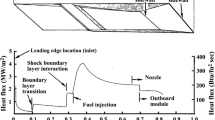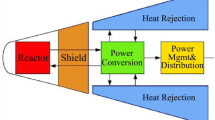Abstract
In this study, sodium/GH4099 heat pipes are proposed for nose cap cooling. X-51 nose cap-like sodium/GH4099 heat pipe spreaders were designed and prepared in China Academy of Aerospace Aerodynamics (CAAA). And their startup properties were tested at a 500 kW quartz lamp calorifier. The experimental results indicated that the sodium/GH4099 heat pipes startup successfully at heat flow of about 75 kW/m2, displaying a uniform temperature of about 800 °C. On the other hand, startup failures were also found. Working fluid of sodium leaked out of the GH4099 shell, resulting in temperature distributions of 684-946 °C. The frozen startup limit of sodium is 2.4, satisfying the criterion for frozen startup. At simulated aerothermal conditions of Ma 5–7, the heat pipe can decrease the stagnation temperature effectively to be lower than end-use temperature of GH4099. Thus, it is concluded that sodium/GH4099 heat pipes are feasible for nose cap cooling.











Similar content being viewed by others
Abbreviations
- A :
-
Area, m2
- c :
-
Specific heat, J/(kg·K)
- c me :
-
Average effective specific heat of the wick over the liquid wick and the solid wick, J/(kg·K)
- FSL:
-
Frozen startup limit
- H:
-
Latent heat due to melting or freezing, J/kg
- HP:
-
Heat pipe
- h fg :
-
Latent heat of vaporization, J/kg
- M cs :
-
Mass flow rate condensed on the solid-wick surface, kg/s
- M t :
-
Working fluid inventory, kg
- Q :
-
Radical heat flux w/m2
- R c :
-
Equivalent space radius in evaporator, m
- R o :
-
Outer pipe wall radius, m
- R υ :
-
Equivalent space radius in condenser, m
- T :
-
Operating temperature of heat pipe, K
- T a :
-
Ambient temperature, or the initial temperature of the frozen heat pipe, K
- T m :
-
Melting temperature, K
- δ :
-
Wall or liquid-wick thickness, m
- \( {\delta}_l^{\hbox{'}} \) :
-
Thickness of the working fluid in the wick, m
- δ w :
-
Thickness of the wall, m
- ε :
-
Radiation emissivity
- ρ :
-
Density, kg/m3
- ρ eff :
-
The effective density of the porous wick, kg/m3
- σ :
-
The Stefan Boltzmann constant (W m−2· K−4)
- φ :
-
Heat pipe wick porosity
- a :
-
Adiabatic or ambient
- eff :
-
(Effective)
- l :
-
Liquid or working fluid in the liquid state in the wick
- m :
-
Mushy phase
- me :
-
Average effective specific heat of wick over the liquid and solid working fluid
- w :
-
Wall or wick
- υ :
-
(Vapor)
References
Ai, B.C., Yu, J.J., Chen, S.Y., Lu, Q., Han, H.T., Hu, L.F.: Fabrication and testing of lithium/C-103 alloy heat pipe for sharp leading edge cooling. Heat Mass Transf. 54, 1359–1366 (2018)
Alario, J.P. and Prager, R.C., "Space shuttle orbit heat pipe application", Nasa Cr-128498, 1972
Camarda, C.J., Masek, R.V.: Design, analysis and tests of a shuttle-type heat-pipe-cooled leading edge. J. Spacecr. Rocket. 18, 71–78 (1981)
Cao, Y., and Faghr,i A., "A numerical analysis of high-temperature heat pipe startup from the frozen state", ASME J. Heat Transfer, 115(1993) 247–254
Cao, Y., Faghri, A.: Closed-form analytical solutions of high-temperature heat pipe startup and frozen startup limitation. ASME J. Heat Transfer. 114, 1028–1035 (1992)
Colwell, G.T., "Cooling Hypersonic Vehicle Structures", Proceedings of Seventh International Heat Pipe Conference, Minsk, U.S.S.R., 1990
Faghri, A., "Analysis of Frozen Startup of High-Temperature Heat Pipes and Three-Dimensional Modeling of Block-Heated Heat Pipes", AD-A245 327, Depart of Mechanical and Material Engineering Wright State University Dayton, on 45435 Nov. 1991
Faghri, A., Buchko, M., Cao, Y.: A study of high-temperature heat pipes with multiple heat sources and sinks: part I—experimental methodology and frozen startup profiles. ASME J. Heat Transfer. 113, 1003–1009 (1993)
Jang, J.H., "A study of start-up Characteristics of a potassium heat pipe from the frozen state". Lewis Research Center Group, Brook Park, Ohio, NASA Contractor report 189173. 1995
Kasen, S.D., “Thermal Management at Hypersonic Leading Edges”, PH.D. Dissertation, University of Virginia, May 2013
Li, G., Li, X.: Effects of reduced gravity conditions on bubble dispersion characteristics in the bubble column. Microgravity Sci. Technol. 28, 441–450 (2016)
Li, J.H., shen, Q., Cheng, X.L.: Investigation of inflow total temperature effect on Kerosen-fueled low internal drag Scremjet combustor performance. Phys Gas. 7, 4–11 (2012) In Chinese
Lu, Q., Han, H.T., Hu, L.F., Chen, S.Y., Yu, J.J., Ai, B.C.: Preparation and testing of nickel-based Superalloy/sodium heat pipes. Heat Mass Transf. 53, 3391–3397 (2017)
Niblock, G.A., Reeder, J.C., Huneidi, F.: Four space shuttle wing leading edge concepts. J. Spacecr. Rocket. 11, 314–320 (1974)
Peeples, M.E., Reeder, J.C., and Sontag, K.E., "Thermalstructural Applications of Heat Pipes0", NASA CR 159096, June 1979
Ponnappan R., "Study on the startup transients and performance of a gas-loaded sodium heat pipe ", technical report, WRDC-TR-89-2046, universal energy system, Inc., Dayton, OH. 1988
Rosenfeld J.H., Ernst D.M., Lindemuth J.E.et al. "An Overview of Long Duration Sodium Heat Pipe Tests [R] ". Lancaster: Thermacore International, Inc., 2004
Rosenfeld, J.H., Minnerly, K.G., Dyson, C.M.: Ten Year Operating Test Results and Post-Test Analysis of a 1/10 Segment Stirling Sodium Heat Pipe Phase III Final Report[R]. Thermacore, Inc., Lancaster (2012)
Rossomme, S., Goffaux, C., Hillewaert, K., Colinet, P.: Multi-scale modeling of radial heat transfer in grooved heat pipe evaporators. Microgravity Sci. Technol. 20, 293–297 (2008)
Silverstein, C.C., "A feasibility study of heat pipe cooled leading edges for hypersonic cruise aircraft", Nasa Cr-1857, 1971
Simanovskii, I., Viviani, A., Dubois, F., Queeckers, P.: Nonlinear convective flows in a laterally heated two layer system with a temperature-dependent heat release/consumption at the interface. Microgravity Sci. Technol. 30, 243–256 (2018)
Steeves, C.A., He, M.Y., Kasen, S.D., Valdevit, L., Wadley, H.N.G., Evans, A.G.: Feasibility of metallic structural heat pipes as sharp leading edges for hypersonic vehicles. J. Appl. Mech. 76, 031014 1–031014 9 (2009)
Acknowledgements
Authors would like to thank Dr. Xuejun Zhang and Dr. Liang Chen for the useful discussions about the results of thermal response simulation.
Author information
Authors and Affiliations
Corresponding author
Additional information
This article belongs to the Topical Collection: Heat Pipe Systems for Thermal Management in Space
Guest Editors: Raffaele Savino, Sameer Khandekar
Publisher’s Note
Springer Nature remains neutral with regard to jurisdictional claims in published maps and institutional affiliations.
Rights and permissions
About this article
Cite this article
Chen, S., Han, H., Shi, J. et al. Applications of Sodium/GH4099 Heat Pipes for Nose Cap Cooling. Microgravity Sci. Technol. 31, 417–424 (2019). https://doi.org/10.1007/s12217-019-09714-w
Received:
Accepted:
Published:
Issue Date:
DOI: https://doi.org/10.1007/s12217-019-09714-w




